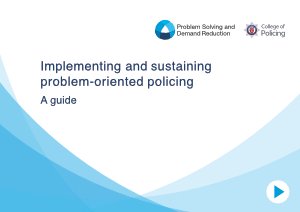By His Majesty’s Inspectorate of Constabulary and Fire & Rescue (UK)
The effective investigation of crime is fundamental to the legitimacy of policing and to public confidence. It also influences how safe people feel and it prevents future offending. When a crime is reported, the public have a right to expect that the police will record and investigate the crime effectively. There has been a long-term decline in successful prosecutions, meaning that too few criminal investigations are leading to justice for victims. There is a general perception among the public that the police aren’t doing a good job of tackling the crimes that affect local communities. Therefore, as part of our 2022–25 programme of inspections, we inspected how effectively the police investigate crime. During our inspection, we saw numerous examples of initiatives forces have introduced to improve the standard of crime investigations and achieve better outcomes for victims. We have included 24 case studies in this report to highlight some of these initiatives. Understanding demand Crime experienced by individuals and households has generally decreased over the last 10 years. However, since 2015, police-recorded crime rates per 1,000 population have increased by 44 percent. Improved police recording practices, and an increase in public reporting of crime, are likely to have contributed to this increase in police-recorded crime. Since 2010, after accounting for changes in the population, the number of police officers in England and Wales has decreased by 6 percent. Over this period, the number of police staff decreased by 13 percent and the number of police community support officers decreased by 59 percent. We have previously reported that a shortage of resources negatively affects the police’s ability to detect crime. During our fieldwork, we heard about a lack of resources in every force we inspected. Interviewees told us that officers and staff often couldn’t investigate crime as well as they wanted to because their workloads were too high, they were under pressure and they didn’t have enough time. Frequently, we also saw the effect of this strain on their supervisors, line managers and chief officers, who repeated the same message. We concluded that in order to investigate volume crime more effectively, forces need more officers and staff. Forces don’t have an in-depth understanding of their crime-related demand. Most forces have a good understanding of their crime patterns, but analysis of future crime rates is inconsistent. The amount of digital evidence that investigators need to gather and examine has increased considerably over the past decade. This increase in digital evidence adds complexity to crime investigations. Forces need to consider this when analysing their crime-related demand.
Birmingham, UK:His Majesty’s Inspectorate of Constabulary and Fire & Rescue, 2025. 135p.





















